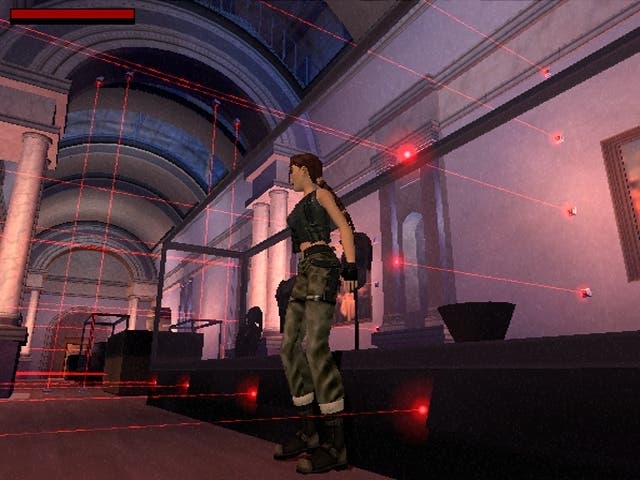Tomb Raider Retrospective
Who's that girl?
When approaching each of the sequels, Core seemed to have a checklist of improvements which went something like this: make the graphics better, the levels bigger, and give Lara new moves, more weapons and better breasts. Bizarrely, the controls were never changed or even tightened, and the mapping of Lara's new moves to the controller often made things worse, although thankfully Core did remove the checkpoints in Tomb Raider II so you could save your progress at any point. The chief graphical improvement was the introduction of 'open' levels with a sky overhead, which allowed the designers to set more of the game outdoors (shown off to great effect in its gorgeous-looking opening level). New real-time light sources made everything look prettier, and flares were available to light up gloomy areas. Lara's main new skill was the ability to climb ladders and scale walls, and while it didn't seem like a big deal, it allowed for more varied level designs. Vehicles were introduced for the first time too, including a motorboat and snowmobile for Lara to speed around on.
There was an obvious 007 influence on the sequel, with more action and shooting at the expense of puzzle-solving. This upset a few fans of the original, but looking back at the series as a whole the first sequel is generally held in high regard and would probably be most people's choice for the remake treatment.
For the third game, Core whipped out the improvements checklists and threw most of its efforts into ramping up the visuals. Triangular building blocks were used to make the levels appear more natural and less LEGO-like, and multi-coloured lighting was utilised. The result was a bit of a mess, sadly, as there was almost too much detail crammed onto the screen. Everything was really dark as well, particularly on the PlayStation where you couldn't just bump up the gamma. Tomb Raider III also stands out as the hardcore entry in the series, as it was amazingly difficult with unpleasant death lying around every smoothed-out corner. Even the first level was daunting, with new elements like quicksand, killer piranhas and devious monkeys all out to get you. But perhaps the biggest criticism is that the level design was lacking. Apart from one fantastically atmospheric level that took place in an abandoned London Tube station, the locations you visited were largely uninspired. There was a distinct lack of tombs too.

November 1999 rolled around and another Tomb Raider appeared. Subtitled The Last Revelation, the fourth game was a back to basics affair that recreated the look and feel of Lara's debut. It was set entirely in Egypt, so there were tombs aplenty, and it featured a welcome return to the puzzle-led gameplay of the original. Despite growing criticism that the series was becoming stale, Core wisely refrained from the unnecessary meddling that spoiled Tomb Raider III and concentrated on refining the elements that made the first game so memorable. The result was a game designed for fans of the series, and they were rewarded for their loyalty with the largest adventure yet - it was roughly twice the size of the original and took around 40 hours to complete. The fourth game was also the first to appear on the SEGA Dreamcast, where Core made use of the more powerful hardware to deliver the best-looking Tomb Raider to date.
The Last Revelation ended with Lara lost in Egypt, presumed dead, but that slight inconvenience wasn't about to stop the yearly releases. Tomb Raider Chronicles appeared in November 2000 and it was very much a stopgap title created to sustain interest in the series while the new next-gen Lara was readied for her PS2 debut. Featuring a series of unconnected episodes from Lara's past, Chronicles presented a solid challenge but was of interest only to her most loyal fans.

Tomb Raider: Angel of Darkness was due to arrive on PS2 and PC in 2002, but following a series of delays it finally appeared during the summer of 2003. It was billed as "A new Lara Croft for a new generation", which was unfortunate as we soon found out that absolutely nothing had changed. It looked better, as you'd expect given the host hardware, but the gameplay was gratingly familiar and the controls, while tweaked, were still clumsy and unintuitive. The AI and level design was poor too, and it really made you wonder what Core had been doing for two and a half years - especially as the Derby-based codeshop had been given PS2 dev-kits as early as 1998. Later on in the game you could take control of Lara's male cohort, Kurtis Trent, but only those with the patience of saints would ever make it that far.
Although it was slightly sad to see Eidos steal Lara away from Core following the Angel of Darkness debacle, it has proved to be a very smart move. Under Crystal Dynamics the series is definitely back on track, and if Underworld is able to improve on Anniversary to the same degree that Anniversary built on Legend, we could be days away from experiencing the best Tomb Raider game in a decade.
Find out in our Tomb Raider Underworld review at 5pm today.








